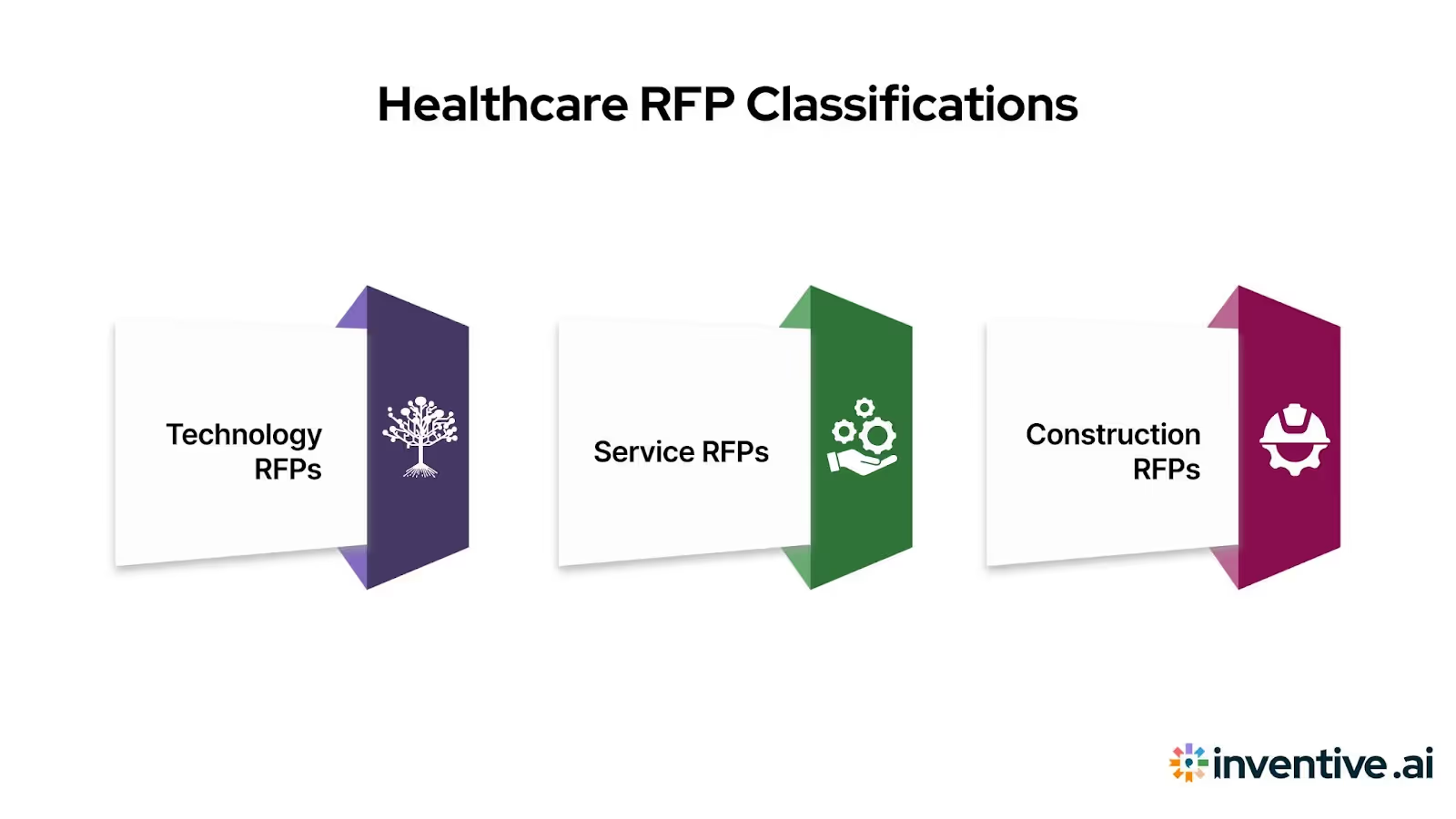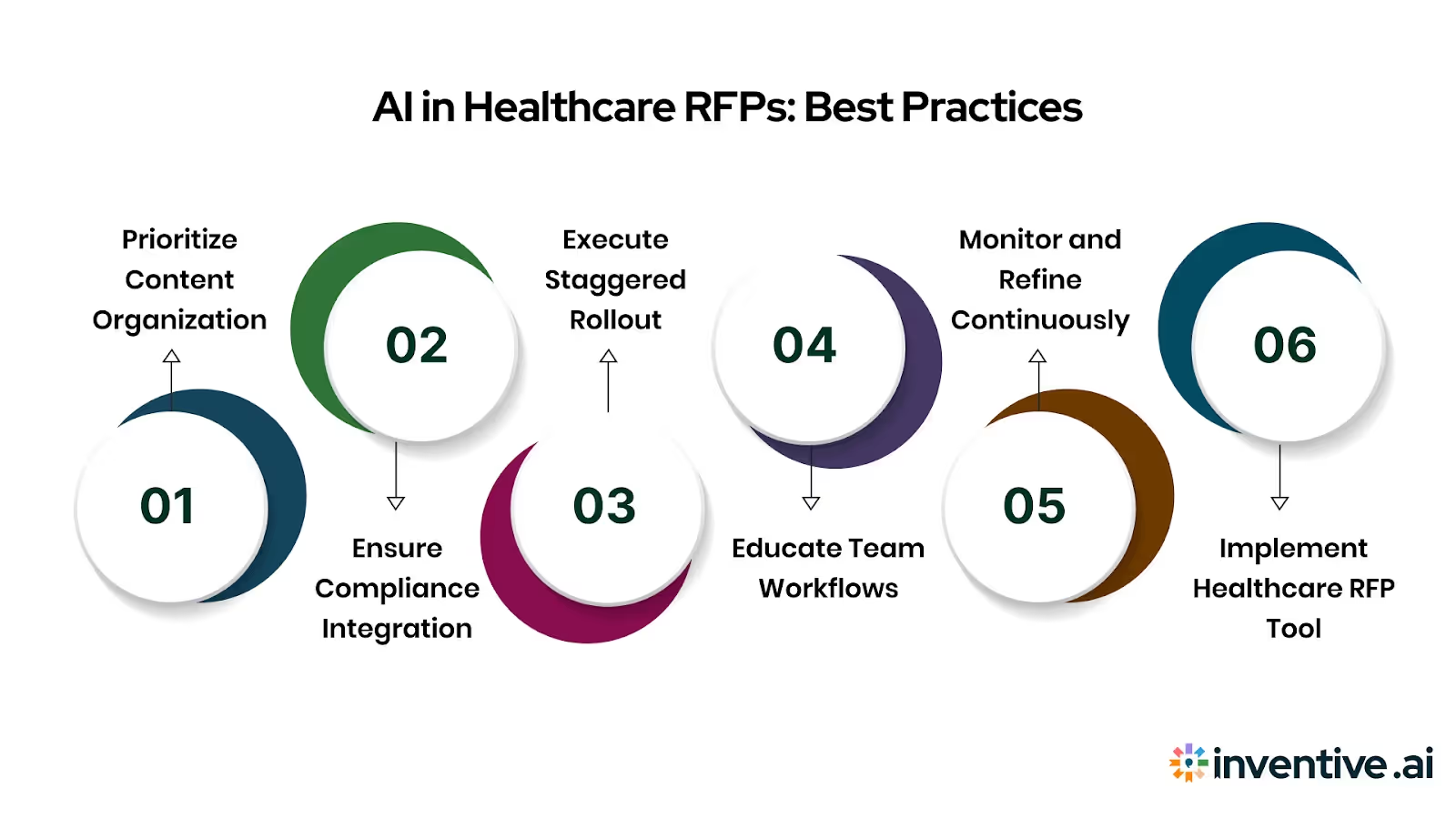Guide to RFP Automation in Healthcare with AI
Learn how healthcare RFP automation significantly reduces response times. Explore best practices to improve your proposal response efficiency with AI.

Responding to healthcare RFPs is a high-pressure, compliance-heavy process where precision, speed, and consistency are critical. HIPAA regulations, clinical data security, complex pricing structures, and exhaustive vendor questionnaires create constant challenges under tight deadlines.
Manual, outdated RFP processes drain valuable hours and increase risk. Proposal teams often waste time searching for content, repeating answers, and managing formatting, while missed deadlines and inconsistent responses lead to lost contracts.
Healthcare AI RFP automation has moved from a convenience to a competitive necessity. As the proposal software market grows toward $5.81 billion by 2030 (from $2.33 billion in 2022), healthcare organizations are rapidly adopting AI-driven tools to automate repetitive tasks, maintain compliance, and focus on high-value decisions.
This guide breaks down how Healthcare RFP automation works, where it delivers the most impact, and how to implement it effectively to gain a clear advantage. Let’s get started.
TL;DR:
- Manual healthcare RFP responses create compliance risks, missed timelines, and inconsistent messaging that can instantly disqualify your proposals.
- AI automation reduces weeks of manual work into days by automatically mapping requirements, retrieving relevant content, and generating compliant draft responses.
- Clean and well-categorized content libraries are essential because poorly organized content makes even advanced AI tools unreliable for healthcare compliance.
- Healthcare-specific platforms handle complex documentation, multi-team workflows, and specialized compliance needs that generic proposal software cannot manage.
What is Healthcare RFP Automation?
Healthcare RFP automation uses artificial intelligence and software tools to manage the entire request for proposal process in medical settings. This technology handles everything from organizing vendor responses to ensuring HIPAA compliance throughout the evaluation process.
For example, consider your team responding to an RFP from a hospital system evaluating electronic health record vendors. Traditional methods require manually searching through past proposals, checking compliance requirements, and coordinating input from multiple team members.
Whereas, automated systems can instantly pull relevant content from your knowledge base, ensure compliance elements are included, and generate draft responses that your team can refine.
The technology works by digitizing your previous RFP responses, using AI to understand content patterns, and applying your company's messaging to new requests. You can upload past proposals, product specifications, and compliance documents. The system then automatically generates responses that match the RFP requirements while maintaining technical accuracy.
This approach particularly benefits vendors selling to healthcare because medical RFPs involve unique challenges like patient safety requirements, regulatory compliance, and complex technical specifications.
Understanding the basics helps, but healthcare RFPs come in different forms that each require specific approaches.
Types of Healthcare RFPs

Healthcare organizations create different types of RFPs based on what they need to buy. Understanding these categories helps your team write better responses that address what buyers care about most.
- Technology RFPs - These RFPs ask for software systems, medical devices, and IT equipment. These require detailed technical specs, integration plans, and compliance certificates. Examples include electronic health records, patient monitoring systems, and medical imaging equipment.
- Service RFPs - They cover consulting, maintenance, and support services. These focus on your experience, methods, and team qualifications. Common examples include medical staffing, equipment repair, and healthcare consulting services.
- Construction RFPs - These RFPs involve building or renovating medical facilities. These need specialized licenses, safety protocols, and knowledge of medical facility rules. Proposal formats for these often include detailed timelines and regulatory compliance documentation.
Each type needs different expertise and documents, but all share common healthcare requirements around patient safety, regulatory compliance, and keeping operations running smoothly.
Knowing which RFP you’re responding to is important. But how automation compares to traditional RFP response processes will help you understand its actual impact.
The Traditional Healthcare RFP Process vs. AI-Driven Automation
Traditional healthcare RFP responses follow a manual process that takes weeks and creates many opportunities for errors. Understanding this difference shows why automation helps healthcare vendors win more business.
The old way of doing RFP responses involves multiple slow steps:
Modern AI automation fixes these problems by keeping all knowledge in one place, doing routine tasks automatically, and maintaining quality standards across every response. Let’s learn more about the top advantages of using AI for responding to healthcare RFPs.
Key Benefits of AI in Healthcare RFP Automation
Healthcare buyers evaluate vendors more rigorously than most industries. Patient safety, regulatory compliance, and integration with existing systems create layers of requirements that manual response processes struggle to address consistently.
As a vendor responding to these complex requirements, AI automation helps you provide thorough, accurate responses while reducing errors. Here's how automation specifically helps your response team:
- Compliance Assurance - Automatically includes required HIPAA, FDA, and regulatory certifications in every response to meet healthcare buyer expectations.
- Content Consistency - Maintains consistent messaging across all proposals while adapting to specific RFP requirements and buyer needs.
- Speed and Accuracy - Generates comprehensive draft responses in minutes rather than days of manual content assembly and review.
- Knowledge Management - Organizes your technical specifications, certifications, and case studies for instant retrieval during tight deadlines.
- Team Collaboration - Enables subject matter experts to review and refine relevant sections without workflow delays or version control issues.
These capabilities become essential when you consider that healthcare RFP mistakes can cost you significant business opportunities. A missing compliance element or inconsistent technical specification creates risks that extend far beyond losing a single deal.
The stakes make automation not just helpful, but necessary for competitive healthcare proposals. Your team benefits from AI RFP response software designed for healthcare compliance needs.
Now, let’s explore how AI actually handles healthcare's complex requirements.
Implementing AI in Healthcare RFP Process: Best Practices and Tips

Successfully implementing AI automation for healthcare RFP responses requires careful planning and attention to industry-specific requirements. You’ll have to create efficient processes while maintaining the thorough proposal management healthcare buyers demand.
1. Unified Knowledge Hub
One of the biggest barriers to successful healthcare RFP automation is scattered, poorly maintained content. Without a structured, verified content library, even the smartest AI tools cannot deliver reliable, compliant results.
Healthcare RFPs involve clinical data, legal statements, compliance documents, and security protocols. Each RFP might ask for different combinations of these, depending on the buyer’s regulatory environment, services offered, and patient population.
How to do it right:
- Conduct a full audit of your existing content. Remove duplicate, outdated, or unapproved documents.Inventive AI has an AI content manager that can automatically remove duplicate content and resolve conflicts, making this process much faster and easier.
- Categorise content by regulatory type, document type, product line, and application area.
- Apply metadata tags to each document. This helps AI systems retrieve the correct files based on RFP requirements.
- Set up regular content reviews to ensure clinical outcomes data, compliance certificates, and technical documentation stay current.
AI-powered searches are only as good as the quality and organization of the content behind them. Clean, structured, and labeled content reduces risk and improves automation accuracy.
2. Ensure Regulatory Compliance Integration
Compliance is the single most critical factor in healthcare proposals. Missing a required document or using an outdated statement can instantly disqualify your bid. Most teams rely on manual checks, but under tight deadlines, mistakes happen.Healthcare buyers closely audit proposals for regulatory compliance. Failing to include a current HIPAA policy, FDA device clearance, or GDPR compliance notice not only costs you the bid but signals poor internal risk management.
How to do it right:
- Use AI systems with rule-based compliance checks. Configure them to automatically verify whether all required documents are included based on the RFP’s industry, geography, and service type.
- Build standard response templates for each regulatory requirement. For example, have pre-approved HIPAA and FDA language ready for insertion where needed.
- Create alerts for missing attachments or inconsistent regulatory statements before submission.
- Update regulatory templates and reference documents as new rules and approvals come into effect.
This ensures every proposal meets current standards without relying entirely on manual oversight.
3. Implement Gradual Rollout Strategy
Many healthcare proposal teams attempt full automation on day one, which often leads to frustration, workflow failures, and abandoned projects. A phased, risk-based rollout delivers far better results.Healthcare RFPs range from simple service agreements to highly complex enterprise technology contracts. Automating a high-value clinical software bid without testing your AI system on simpler projects first introduces unnecessary risk.
How to do it right:
- Segment your RFP workload into three tiers based on complexity.
- Tier 1: Basic service contracts (equipment maintenance, support services).
- Tier 2: Mid-level projects (clinical software licenses, non-invasive device purchases).
- Tier 3: Complex IT or invasive device projects involving extensive regulatory and clinical data.
- Start automation with Tier 1 RFPs. Validate your workflows, content selection accuracy, and compliance checks.
- Expand to Tier 2 and Tier 3 only when early projects run smoothly and team members understand the system.
This builds operational confidence, reveals hidden process gaps early, and allows adjustments before risking major opportunities.
Want to see how AI can improve your healthcare proposal process? At Inventive AI, we offer an in-depth 7-step buying guide to help you evaluate automation solutions designed for complex healthcare decisions.
4. Train Teams on New Workflows
Healthcare RFPs involve multiple disciplines. Clinical experts, IT architects, security officers, legal advisors, and sales teams each play a role. A single, generic training session for everyone doesn’t work.If teams don’t understand how the AI-driven process affects their responsibilities, resistance increases, errors occur, and proposal quality suffers.
How to do it right:
- Develop training modules tailored to each role.
- Clinical reviewers should learn how to verify medical accuracy and clinical outcome data efficiently.
- Technical staff should know how to check system requirements and integration documentation.
- Compliance officers must manage security statements and regulatory sections.
- Sales teams need to adjust messaging for different healthcare buyers, from small clinics to large health systems.
Use simulated RFP scenarios to train each team on handling specific situations. For example, practice responding to a hospital network RFP for remote patient monitoring devices, assigning tasks to each department.
This approach ensures clarity, increases adoption, and prevents workflow breakdowns.
5. Monitor and Refine Continuously
A common mistake is assuming that AI systems, once installed, will run flawlessly without oversight. Healthcare RFPs are dynamic. Regulations change, new competitors enter the market, and client expectations evolve.Outdated content, poor AI recommendations, and unmonitored compliance can damage your credibility and reduce win rates.
How to do it right:
- Track key metrics like proposal completion time, win rates, compliance incident frequency, and team satisfaction with automation tools.
- Regularly review content performance to identify which documents are overused, outdated, or rarely selected.
- Gather team feedback on workflow bottlenecks or missing features.
- Adjust system rules, templates, and document libraries based on actual performance data, not assumptions.
Continuous monitoring keeps your AI workflows sharp, compliant, and aligned with healthcare procurement trends.
6. Choose a Healthcare-Specific RFP Automation Platform
Generic proposal tools aren’t built for the complexity of healthcare RFPs. These projects involve technical documentation, clinical data, and multi-team collaboration that standard software struggles to manage.Healthcare RFPs require handling large volumes of specialized content, coordinating inputs from multiple teams, and meeting strict deadlines. The wrong platform slows teams down, increases errors, and produces inconsistent proposals.
How to do it right:
Use an automation platform designed for healthcare RFP workflows, offering:
- Centralised, version-controlled content management for clinical, technical, and commercial documents
- Role-based workflow tools for smooth handoffs between clinical, IT, legal, and sales teams
- AI-driven content suggestions tailored to healthcare language and proposal structures
- Flexible templates and content frameworks for managing complex, detail-heavy RFPs
The right platform keeps your proposals fast, accurate, and consistent — without the inefficiencies of generic tools.
Want to see how AI can speed up your healthcare RFP process by 90%? Book a demo with Inventive AI to explore automated solutions designed for complex healthcare proposals.
Knowing how healthcare RFP response automation works is one thing. But for implementing it successfully, it’s essential to learn more about the common challenges you might face while automating your RFP responses.
Overcoming Common Challenges When Automating Healthcare RFPs
Healthcare vendors face unique obstacles when implementing RFP automation, mainly due to the industry's complex regulatory environment and high-stakes decision-making requirements.
Here are some of the common challenges your could face while automation Healthcare RFP responses:
- Content Quality Control - Ensuring automated responses maintain your company's expertise and brand voice while meeting strict healthcare buyer standards.
- Integration Complexity - Connecting automation platforms with existing CRM systems, technical documentation, and compliance databases used by your team.
- Regulatory Updates - Keeping automated content current with changing healthcare regulations and compliance requirements that buyers expect.
- Team Adoption - Getting subject matter experts comfortable with new technology while maintaining proposal quality standards your company demands.
- Buyer Variation - Healthcare buyers range from small clinics to large health systems, creating diverse RFP formats and requirements that challenge automation.
Understanding these challenges helps your team prepare appropriate solutions to overcome them and set realistic expectations for automation implementation. Most obstacles can be addressed through careful planning and AI RFP software selection.
These challenges are worth considering, but they don't have to slow you down when you have the right solution. Here's how you can implement AI to handle the common healthcare RFP problems.
Want to know about the potential cost savings from RFP automation? Our ROI calculator will help you estimate time and resource savings from automated proposal processes.
Final Thoughts
Healthcare RFP response automation is a significant opportunity for vendors to improve proposal efficiency while maintaining the thorough expertise standards healthcare buyers demand. Teams that implement AI-powered solutions report faster response times, better proposal quality, and reduced administrative burden on technical and sales specialists.
The right platform will handle routine tasks while preserving human oversight for strategic messaging and relationship building. Inventive AI is an AI RFP Agent that provides the specialised capabilities healthcare vendors need to automate their RFP processes effectively.
Ready to see how AI automation can improve your healthcare proposal process? Request a demo to explore solutions designed specifically for healthcare RFP response management.
FAQs
- What's the difference between healthcare RFPs and regular business proposals?
Healthcare RFPs involve stricter compliance requirements like HIPAA and FDA regulations, patient safety protocols, and complex technical specifications. They also require extensive documentation for clinical outcomes and security certifications that standard business proposals don't need.
- Can AI automation handle specialised medical terminology and clinical requirements?
Yes, healthcare-specific AI platforms are trained to understand medical terminology, clinical workflows, and regulatory language. They can maintain technical accuracy while adapting content to specific RFP requirements and buyer needs.
- What happens if regulatory requirements change after we've automated our responses?
AI systems with proper content management allow quick updates to regulatory templates and compliance documents. Set up regular content reviews and automated alerts to ensure all regulatory statements stay current across your proposal library.
- Is RFP automation suitable for small healthcare vendors with limited resources?
Yes, automation actually benefits smaller teams more by reducing time-consuming manual tasks. Start with basic service RFPs first, then expand as your team becomes comfortable with the technology.


